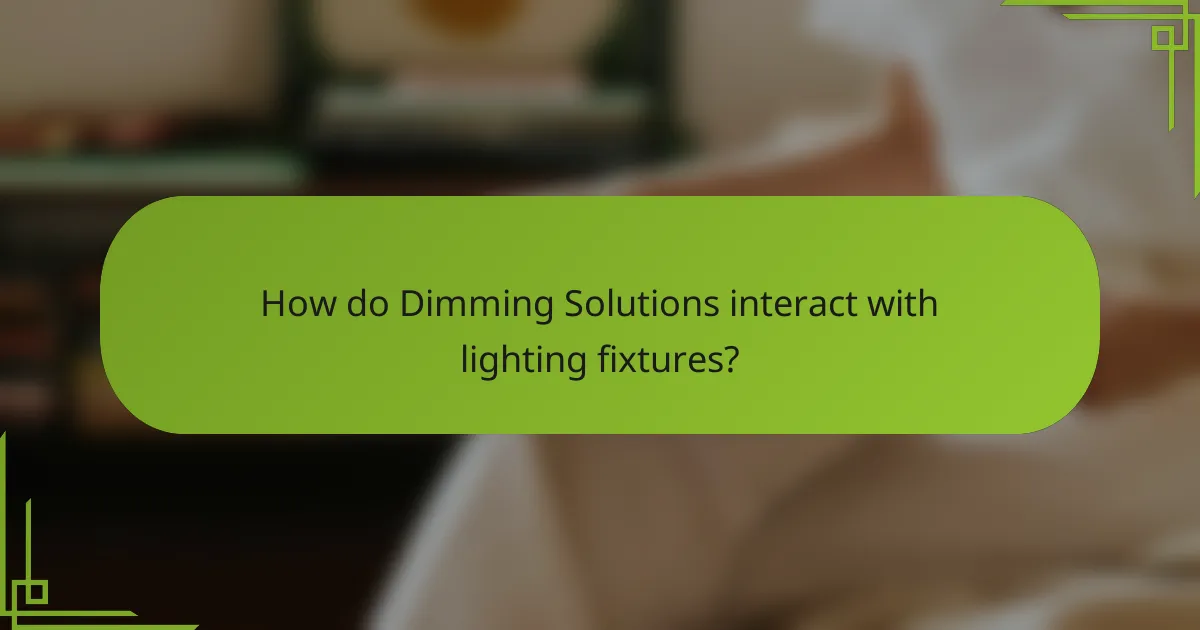
What are Dimming Solutions?
Dimming solutions are systems designed to adjust the brightness of lighting fixtures. They allow users to control light levels for various settings. Common types include manual dimmers, smart dimmers, and programmable systems. Manual dimmers operate through a physical switch. Smart dimmers can be controlled via apps or voice commands. Programmable systems can automate lighting based on schedules or occupancy. Dimming solutions improve energy efficiency by reducing power consumption. They also enhance ambiance and comfort in residential and commercial spaces. Studies show that dimming can extend the lifespan of light sources.
How do Dimming Solutions function in lighting systems?
Dimming solutions function by adjusting the brightness of lighting fixtures. They achieve this through various methods, such as changing voltage levels or altering the current supplied to the lights. This modulation allows users to create desired lighting atmospheres. Dimming can enhance energy efficiency by reducing power consumption. It also extends the lifespan of bulbs by minimizing heat output. Common dimming technologies include phase-cut dimmers and digital dimming systems. These technologies can be compatible with different types of lighting, including LED, incandescent, and fluorescent. Studies indicate that dimming can reduce energy use by up to 30% in residential settings.
What components are essential for Dimming Solutions?
Essential components for dimming solutions include dimmers, control systems, and compatible light fixtures. Dimmers regulate the amount of electricity supplied to a light source. Control systems allow for remote operation and automation of lighting. Compatible light fixtures are designed to work effectively with dimmers. Each component must be properly matched for optimal performance. According to the Lighting Research Center, incorrect pairing can lead to flickering or reduced lifespan of bulbs. Therefore, understanding these components ensures effective dimming solutions.
How do different components interact within Dimming Solutions?
Different components within dimming solutions interact through a system of control signals and electrical connections. Dimmers regulate the power supply to lighting fixtures, adjusting brightness levels. Control components, such as switches and remote controls, send signals to the dimmer. The dimmer then modifies the voltage and current supplied to the light source. This interaction allows for smooth transitions in lighting intensity. Compatibility between components is crucial for optimal performance. For example, LED dimmers must match the specifications of LED fixtures to prevent flickering. These interactions ensure energy efficiency and enhance user control over lighting environments.
What benefits do Dimming Solutions provide?
Dimming solutions provide enhanced control over lighting levels. They allow users to adjust brightness according to specific needs. This flexibility can lead to energy savings by reducing power consumption. Studies show that dimming can cut energy use by up to 20%. Additionally, dimming solutions contribute to longer bulb life. Lowering light intensity can reduce heat output, extending the lifespan of lighting fixtures. Furthermore, they improve ambiance and comfort in various settings. Properly dimmed lighting can enhance mood and productivity in workspaces. Overall, dimming solutions offer practical benefits for energy efficiency, longevity, and user satisfaction.
How do Dimming Solutions enhance energy efficiency?
Dimming solutions enhance energy efficiency by allowing users to adjust lighting levels according to their needs. This adjustment reduces energy consumption, as lights use less power when dimmed. Studies show that dimming can lead to energy savings of up to 30% in commercial settings. By lowering the intensity of illumination, less electricity is drawn from the grid. Additionally, dimming extends the lifespan of light sources, reducing the frequency of replacements. This further contributes to overall energy savings and less waste. Dimming solutions also improve occupant comfort by providing the right light levels for various activities.
What impact do Dimming Solutions have on mood and ambiance?
Dimming solutions significantly impact mood and ambiance by allowing control over lighting intensity. Adjusting light levels can create a cozy or vibrant atmosphere. Lower light levels often promote relaxation and comfort, enhancing social interactions. Conversely, brighter settings can increase alertness and focus. Research shows that lighting affects emotional well-being. A study published in the Journal of Environmental Psychology found that dim lighting can lead to more positive mood states. This adaptability makes dimming solutions essential for various environments, from homes to workplaces.
How do Dimming Solutions contribute to extended bulb life?
Dimming solutions contribute to extended bulb life by reducing the electrical current supplied to the bulb. This lower current decreases heat generation within the bulb. Excessive heat is a primary factor that shortens bulb lifespan. By operating at reduced brightness, bulbs experience less thermal stress. For example, LED bulbs can last up to 25,000 hours when dimmed, compared to 15,000 hours at full brightness. Moreover, dimming can minimize flickering, which can also degrade bulb components over time. Therefore, using dimming solutions effectively enhances the longevity of bulbs.

What types of Dimming Solutions are available?
The types of dimming solutions available include phase-cut dimming, 0-10V dimming, digital addressable lighting interface (DALI), and pulse-width modulation (PWM). Phase-cut dimming is commonly used with incandescent and LED lights. It works by cutting off a portion of the electrical waveform. 0-10V dimming is often utilized in commercial settings. It allows for smooth dimming by varying the voltage sent to the light fixture. DALI is a more advanced system that enables individual control of multiple fixtures. PWM is used primarily in LED applications to control brightness by adjusting the power supply. Each dimming solution has specific applications based on compatibility with different lighting technologies.
What are the different categories of Dimming Solutions?
The different categories of dimming solutions include leading-edge dimming, trailing-edge dimming, and 0-10V dimming. Leading-edge dimming is typically used with incandescent and some LED lights. It works by cutting off the beginning of the waveform. Trailing-edge dimming is more compatible with modern LED lights. It cuts off the end of the waveform, providing smoother dimming. 0-10V dimming is a standard for commercial applications. It allows for control via a low-voltage signal. Each category has unique characteristics suited for different lighting technologies.
How do analog and digital dimmers differ?
Analog dimmers adjust the brightness of lights by varying the voltage supplied to the fixture. This method is typically less efficient and may cause flickering or humming. Digital dimmers use electronic controls to modulate the power delivered to the light source. They often provide smoother dimming and can support advanced features like remote control and programmable settings. Analog dimmers are generally simpler and less expensive, while digital dimmers offer greater functionality and compatibility with modern lighting technologies.
What are the features of smart dimming solutions?
Smart dimming solutions feature automated light adjustment based on ambient light levels. They enhance energy efficiency by reducing power consumption. These solutions often integrate with smart home systems for remote control. Users can customize lighting scenes and schedules through mobile apps. Compatibility with various light fixtures is typically ensured. Some systems allow voice control for added convenience. Many smart dimming solutions provide feedback on energy usage. They also support multiple dimming methods, including phase-cut and 0-10V dimming.
What are the advantages of each type of Dimming Solution?
The advantages of each type of dimming solution vary based on their technology and application. Leading types include leading-edge, trailing-edge, and smart dimmers.
Leading-edge dimmers are compatible with incandescent and some halogen bulbs. They provide a simple and cost-effective solution for basic dimming needs.
Trailing-edge dimmers are suitable for LED and CFL bulbs. They offer smoother dimming and reduced flicker compared to leading-edge options.
Smart dimmers allow remote control and integration with home automation systems. They enhance convenience and energy efficiency by enabling customizable lighting schedules.
Each type serves specific lighting needs, ensuring optimal performance based on the bulb type and user requirements.
How does compatibility with various light sources affect Dimming Solutions?
Compatibility with various light sources significantly impacts dimming solutions. Different light sources, such as LED, incandescent, and fluorescent, require specific dimming technologies. For instance, LED lights often use pulse-width modulation (PWM) for effective dimming. Incandescent lights typically utilize a phase-cut dimming method.
Fluorescent lights may need compatible electronic ballasts for dimming. Mismatched dimming solutions can lead to flickering or reduced lifespan of the light source. Additionally, certain dimmers are designed to work with multiple types of bulbs, enhancing overall system compatibility.
Research indicates that using the correct dimmer can improve energy efficiency by up to 20% in LED applications. Therefore, ensuring compatibility with the light source is crucial for optimal performance and longevity.
What unique features do advanced Dimming Solutions offer?
Advanced Dimming Solutions offer features like precise light control and energy efficiency. They enable smooth dimming without flicker or noise. These solutions often include smart technology integration for remote operation. Many advanced systems allow for customizable lighting scenes. They can also adapt to different types of light sources, such as LED and incandescent. Enhanced compatibility with home automation systems is another unique feature. Some solutions provide real-time energy monitoring capabilities. These features collectively enhance user experience and optimize energy usage.

How do Dimming Solutions interact with lighting fixtures?
Dimming solutions interact with lighting fixtures by regulating the amount of electrical power supplied to them. This interaction allows for the adjustment of brightness levels in various lighting setups. Dimming solutions can be integrated into fixtures through compatible dimmable drivers or bulbs. For example, LED fixtures often require specific dimmable drivers to function correctly with dimming solutions. The compatibility of dimming solutions and fixtures is crucial for optimal performance and to prevent flickering. Studies indicate that using appropriate dimming solutions can enhance energy efficiency by reducing power consumption. Additionally, dimming can extend the lifespan of lighting fixtures by minimizing heat output.
What fixtures are compatible with Dimming Solutions?
Dimming solutions are compatible with various types of fixtures. These include LED fixtures, incandescent bulbs, and fluorescent lights designed for dimming. Many modern LED fixtures are specifically engineered for compatibility with dimming systems. Incandescent bulbs naturally work with dimmers due to their design. Certain types of fluorescent lights, particularly those labeled as dimmable, can also function with dimming solutions. Compatibility often depends on the dimmer switch used and the specific fixture model. Always check manufacturer specifications to ensure proper compatibility. This ensures optimal performance and prevents issues like flickering or reduced lifespan.
How does the type of bulb influence dimmer compatibility?
The type of bulb significantly influences dimmer compatibility. Different bulb types, such as incandescent, LED, and CFL, have varying electrical characteristics. Incandescent bulbs are generally compatible with most dimmers due to their simple resistive load. LED bulbs require specific dimmers designed for their electronic circuitry. Using a standard dimmer with LED bulbs can lead to flickering or inadequate dimming range. CFLs also need compatible dimmers, similar to LEDs, to function correctly. Manufacturers often specify compatibility in product documentation. Using the correct dimmer ensures optimal performance and longevity of the bulbs.
What should be considered when pairing dimmers with fixtures?
When pairing dimmers with fixtures, compatibility is crucial. Ensure the dimmer is rated for the specific type of bulbs used. For example, LED bulbs require compatible dimmers designed for their lower wattage. Check the wattage rating of both the dimmer and the fixture. Exceeding the wattage can lead to failure or fire hazards. Consider the dimming technology; trailing edge dimmers work better with LEDs, while leading edge dimmers suit incandescent bulbs. Verify the fixture’s voltage; most dimmers are designed for standard 120V systems. Finally, review the manufacturer’s recommendations for both dimmers and fixtures to ensure optimal performance and safety.
What are common issues with Dimming Solutions and fixtures?
Common issues with dimming solutions and fixtures include flickering lights, compatibility problems, and reduced lifespan of bulbs. Flickering can occur due to mismatched dimmer types and bulbs. Compatibility issues arise when LED bulbs are used with older dimmers designed for incandescent bulbs. This can lead to poor performance and inefficiency. Additionally, using incompatible fixtures can cause overheating, leading to potential hazards. Reduced lifespan of bulbs is often a result of constant dimming and incompatible technology. These issues highlight the importance of selecting appropriate dimming solutions for specific fixtures.
How can users troubleshoot flickering lights with Dimming Solutions?
Users can troubleshoot flickering lights with dimming solutions by checking the compatibility of the dimmer switch with the light bulbs. Incompatible dimmers can cause flickering issues. Next, users should ensure the light bulbs are securely installed in their sockets. Loose connections can lead to inconsistent power supply.
Additionally, users should inspect the total wattage of the bulbs connected to the dimmer. Exceeding the dimmer’s wattage rating can cause flickering. Users can also try replacing the bulbs with compatible dimmable LED or CFL bulbs. Non-dimmable bulbs will not work properly with dimming solutions.
Lastly, users should consider resetting the dimmer switch. Sometimes, a simple reset can resolve flickering issues. Following these steps can help users effectively troubleshoot flickering lights with dimming solutions.
What steps can be taken to ensure optimal performance of Dimming Solutions with fixtures?
To ensure optimal performance of dimming solutions with fixtures, select compatible dimmers and fixtures. Compatibility prevents flickering and ensures smooth operation. Use LED-compatible dimmers for LED fixtures to maximize efficiency. Adjust the load to match the dimmer’s specifications for best results. Regularly check connections and wiring for any signs of wear or damage. Test dimming ranges to confirm consistent performance across brightness levels. Consider environmental factors, such as temperature, that may affect performance. Finally, consult manufacturer guidelines for specific recommendations on installation and usage.
What best practices should be followed when using Dimming Solutions?
Use dimming solutions effectively by selecting compatible dimmers for your lighting fixtures. Ensure the dimmer’s wattage rating meets or exceeds the total wattage of the connected lights. Install the dimmer according to manufacturer instructions for safety and optimal performance. Test dimming levels to find the ideal brightness for different tasks and moods. Regularly check for updates or compatibility issues with smart home systems if applicable. Utilize LED-compatible dimmers to avoid flickering and ensure smooth operation. Always consult product specifications for both lights and dimmers to ensure compatibility.
Dimming solutions are systems that adjust the brightness of lighting fixtures, enhancing energy efficiency and ambiance in various settings. This article explores the types of dimming solutions, including manual, smart, and programmable systems, and their essential components, such as dimmers and control systems. It discusses how these solutions function, their benefits like extended bulb life and improved mood, and the importance of compatibility with different light sources. Additionally, the article addresses common issues and best practices for optimizing dimming solutions with fixtures.
